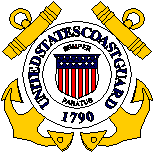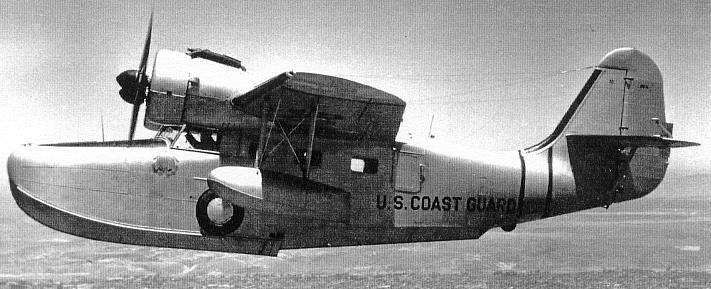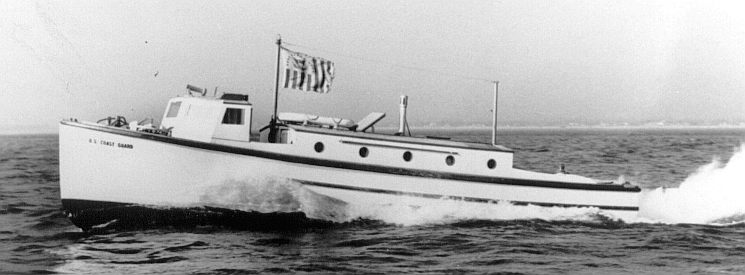|
By
J. R. Lee, AOC, USCG, Retired, and Ted A. Morris,
Lt. Col., USAF, Retired

Late in the afternoon of April 16, 1950,
William Strecker and Gus Detrick of Miami, Florida,
made ready Strecker’s 35-foot cabin cruiser,
Moonlight, for an evening of fishing about 30 miles
south of Miami. Their destination was south of
Cape Florida, near Elliott Key at the south end of
Biscayne Bay. The most important thing Mr.
Streker did was to inform his wife where they were
going, and when they would return.
At almost the same time that day, another boat
prepared to leave Miami. Mrs. Rosa Pent, her
16-year old daughter, and friends Mr. and Mrs. Chester
Smallwood, and Mrs. J. D. Howard, decided to take a
late evening cruise in the Howard’s 18-foot speed
boat, Butch. They did not notify anyone of their
plans, where they would be, or when they would return.
Afternoon became evening, then night. In
the pre-dawn of April 17, 1950, Mrs. Strecker,
concerned about her husband’s continued absence,
called the Coast Guard’s emergency telephone number
for the Miami area. She was quickly connected to
the 7th Coast Guard District’s Rescue Coordination
Center (RCC), which quickly set into motion a search
for the Moonlight and its occupants.
Miami Coast Guard Air Station at Dinner Key
was the station tasked with the search. The Air
Station was adjacent to the pre-W.W.II Pan American
World Airways “Seadrome,” and the Coast Guardsmen
there made ready their Grumman JRF-5, Bureau Number
37804 for launch. The JRF-5 was a twin engine
amphibian with a cruising speed of 150 mph and able to
remain airborne during a search for about five
hours. Pilot LT.(jg) C. R. Leisy, Aviation Chief
Radioman (ALC) Halstead, and Aviation Machinist Mate
Third Class (AD-3) Paul Freund were the crew that
morning. With AD-3 Freund in the copilot’s seat
as a searcher, LT. Leisy taxied down the seaplane ramp
and made a water take off at first light.

JRF-5 "Goose" Amphibian.
Built by Grumman Aircraft
Company. About 25 were used by the U.S.
Coast Guard for short and medium range Search
and Rescue missions from 1939-1955. The
aircraft had a gross weight of 8,700 pounds with
220 gallons of fuel. Its range was 800
miles at about 150 miles per hour. It was
powered by two R-985-AN6 9-cylinder Pratt and
Whitney Wasp Jr. engines, which produced 400
horsepower at take off.
Armed with the knowledge of the general area
to which the Moonlight had been bound, LT. Leisy, a
veteran of numerous such rescue operations, began the
search. He flew a fairly standard search pattern
- beginning at the most probable location of the
vessel, and flying an ever-enlarging box pattern to
locate the boat. After nearly two hours of
searching, Radioman Halstead sighted a vessel as they
passed southeast of Cape Florida between Key Biscayne
and Elliott Key. Lieutenant Leisy flew down
close to the water’s surface and was able to identify
the cruiser as Moonlight by her name across the stern.
He notified the RCC by radio that the vessel
appeared to be disabled and drifting, but that the two
occupants appeared to be okay. He requested a
surface vessel be sent to aid the Moonlight back to
port, and the RCC dispatched a 38-foot picket boat
from the MacArthur Causeway Coast Guard Base to
perform that duty.
Since they had no radio contact with the
Moonlight, LT. Leisy had AD-3 Freund drop a message to
the Strecker and Detrick that help was on the
way. He did this using a wooden “message block”
which had a long yellow streamer attached.
Receiving an O.K. signal from the Moonlight, Leisy
then flew north toward the Coast Guard Base on the
causeway, making radio contact with the 38-foot picket
boat. He gave the picket boat’s crew the
location of the Moonlight and an compass heading for a
successful rendezvous. He then flew back to the
Moonlight and dropped a MK6 smoke light near the
inoperative vessel. The MK6 would give a
45-minute long smoke signal for a visual reference for
the picket boat’s crew as they grew near. Having
ensured the rescuers and the Moonlight would
rendezvous, and with over half of his fuel expended,
LT. Leisy set course for the Dinner Key Air Station,
having performed a good morning’s work.
Minutes later, crew member Freund shouted,
“Lieutenant, there are four people down there in the
water!”
Lieutenant Leisy immediately banked the JRF
around and soon sighted four survivors of the Howard’s
speed boat, Butch. Late in the evening of April
16th, while Joanne Pent was steering the boat, it
apparently struck an under water obstruction, tearing
the bottom from the speed boat and throwing the five
occupants into Biscayne Bay. The Butch sank
immediately, and the survivors managed to cling to the
engine cover and several buoyant cushions which had
floated to the surface. By the time they were
spotted by AD-3 Freund, they had been in the chilly
waters for over 14 hours.
Had it not been for a remarkable coincidence
and a professional Coast Guard aircrew, they would all
have died in the water. No one knew they had
gone boating, where they went or when they would
return. In fact, no one even knew that they were
missing!
Lieutenant Leisy recognized a life or death
emergency when he saw one, and he immediately notified
the RCC of the situation as he set up for a water
landing. Taxiing up close, he noted that the
survivors were too weak to swim to the aircraft, and
rightly suspected they were in fact too weak to fend
off the airplanes hull if he attempted to taxi to
them. To avoid injuries, Freund stripped to his
shorts and, taking a rescue life line, plunged into
the bay, which is pretty cold in April. Freund
swam to the group and grabbed hold of the engine cover
to which the survivors clung with their last bits of
strength. He then signaled Leisy and Halstead to
pull them to the aircraft. The survivors were
all suffering from hypothermia and were almost
completely unable to assist in their own rescue.
After considerable work, the Coast Guard crew
got the four survivors on board the aircraft.
Unfortunately, they were not in time to save Joanne
Pent’s mother, Rosa. An hour before they were
spotted, the older Mrs. Pent had weakened to the point
where she could not hold on any longer, and the other
survivors were too weak to help, and she had sank
beneath the surface.
Lieutenant Leisy knew the survivors needed
immediate medical help. Before attempting to
depart, however, he placed two MK6 smoke lights in the
water to mark the location for a boat search for Rosa
Pent. He then attempted a water take off, but
the JRF was overloaded and he could not get
airborne. The only alternative was to set course
for a long water taxi back to the Air Station at
Dinner Key. Applying full power to the two
engines, Leisy got the JRF up “on the step” and
started a high speed taxi to the Air Station.
Radioing ahead, Halstead arranged for ambulances and
medical personnel to be on hand to take the survivors
to Miami hospitals.
Meanwhile, RCC sent a 30-foot crash boat from
Dinner Key Air Station to the area to pick up the
debris and search for Mrs. Rosa Pent. The search
crew recovered Mrs. Pent’s body about an hour later.
Thanks to Mr. Strecker’s information to his
wife, and the professionalism of LT. Leisy and his
crew, six more names were added to the Coast Guard’s
long list of lives saved. Lieutenant Leisy,
Radioman Halstead, and Aviation Machinist Mate Freund
each received a Letter of Commendation for their
outstanding professionalism during their lifesaving
mission of April 17, 1950.

A 38-foot Picket Boat.
About 540 were built by several
different companies in Michigan, Washington,
Maine, Massachusets and Florida during the
1930s. The U.S. Coast Guard used them
initially during the Prohibition Wars, and they
remained in service until the mid-1950s for law
enforcement and Search and Rescue missions along
coastal and inland waters.
The wooden-hulled boat was powered by
a 6-cylinder, 225 horsepower Hall Scott or
Kermath gasoline engine.
Range was about 200 miles at 10 knots.
|